When they sat down on the carpeted floors in two rooms inside the Hart Senate Office Building – sometimes huddling underneath banners, other times fielding questions from the media – they knew they’d likely be escorted out in restraints.
On December 15, seven Dreamers, plus one ally, took over the offices of Senate Minority Leader Chuck Schumer and Florida Rep. Carlos Curbelo to demand that they pass a clean DREAM Act before December 22. It was a quieter scene than a November protest, which saw hundreds of DREAMers in bright orange tees rushing the building and unfurling a giant banner that spanned several floors. That day, the noise in the government office was overwhelming, rivaling the sonic intensity of a sporting event. But with just seven days left before their deadline, the Dream 7 – as they were nicknamed – knew the actions they took inside the senate office building in December didn’t need to be loud; they just had to be bold.
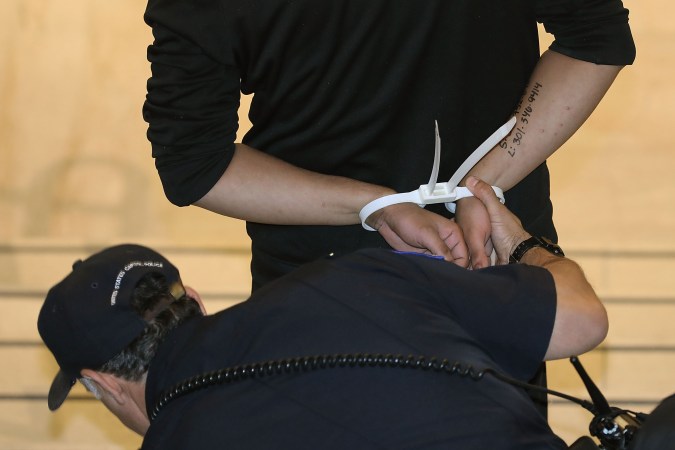
“We shared our stories and repeatedly sang, ‘We love our families more than you will ever know, we planted seeds and we need them to grow,” Cata Santiago, one of the participants, tells Remezcla. “From the get-go, we decided not to cooperate, we didn’t move. Police officers grabbed us, and for me, there was great potential for being harmed… They told us, ‘This is stupid. Why are you doing this?'”
“They told us, ‘This is stupid. Why are you doing this?'”
The answer was simple: They wanted to protect their undocumented family members, friends, neighbors, and the community as a whole. That night in Curbelo’s office, Cata was arrested for the third time. She and the other protesters refused to give officials their names, and outlets reported that Immigration and Customs Enforcement had been called on Erika Andiola, one of the country’s most well-known immigration activists. But even with rumors of deportation in the air, the activists didn’t back down. As they sat in jail, they went on a hunger strike.
Cata wound up serving six days in jail, but a strike on her record couldn’t compare to the fact that 800,000 young immigrants’ future hung in the balance. “I plan on doing whatever is necessary. I risk losing [the place] I see as my home and being away from family,” she says.
Cata is just one of the Deferred Action for Childhood Arrivals (DACA) recipients whose lives were thrown into turmoil when the Trump Administration rescinded the program on September 5. Since 2012, DACA has allowed young immigrants who were brought to the US unlawfully as children to live and work without the fear of deportation. With the end of the program, the administration set a March 5 deadline for Congress to pass legislation that would provide a solution for the DACAmented.
Santiago’s DACA expires in just 10 months. And every day, 122 people lose their DACA status under Trump’s directive. This number will rise to 1,000 a day if Congress doesn’t meet the March 5 deadline. With the clock ticking, activists are putting it all on the line. It’s why Santiago risked arrest, even deportation, to demand action.
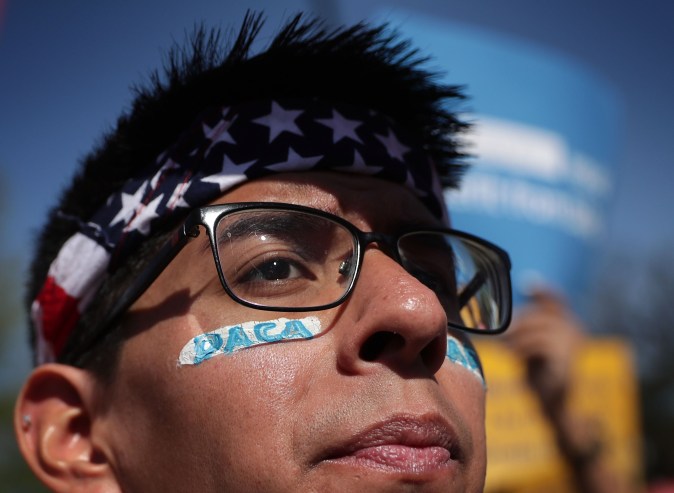
DACA would never have existed had it not been for confrontational tactics like this. After the DREAM Act, first introduced in 2001, stalled in Congress several times, a youth movement emerged to take matters into its own hands. Using highly public, in-your-face tactics – hunger strikes, occupations, marches – these young immigration activists became the faces of the national immigration debate. They tirelessly pressured President Obama to take action, resulting in DACA in 2012. It was a life-changing program for people like 26-year-old Irving Calderon.
Calderon doesn’t remember his native Mexico or journey into the United States – he was seven months old when he arrived in this country. Like many undocumented youths, Calderon didn’t realize he wasn’t a citizen at first. He was 12 when his mom told him: No tienes papeles. “That was a shock to me,” he says. “I always thought I was born in the US.” In high school, he understood for the first time what his status meant for his future: He couldn’t get a driver’s license, and he couldn’t get scholarships for college, despite having a 4.0 GPA.
“The administration is actively looking to de-legalize people so their pool [for deportation] can be bigger.”
“There were a lot of difficulties in college, too,” says Calderon, who applied to the University of Texas at Austin as a foreign student. “I couldn’t work. I continued to get loans even just to pay for my food. I couldn’t get internships.”
After DACA, Calderon was able to get a driver’s license at age 21 and eventually a job in IT at General Motors in Austin. But now, DACA recipients like him find themselves fighting for their lives once again.
This time, the fight is taking place amidst one of the most fractured political moments in his lifetime. The election of Donald Trump – a candidate who made unauthorized immigration a signature campaign issue – was ushered into office on a wave of xenophobic sentiment. Since then, immigrant activists say they’ve seen a swift change – for the worse – on immigration policy and reform.
In 2017, the administration took three big actions on immigration: ending the DACA program, terminating the Temporary Protected Status for Haitians, Salvadorans, Sudanese, and Nicaraguans, and enacting the third version of Trump’s “Muslim ban,” which puts restrictions on citizens from six Muslim-majority countries, North Korea, and Venezuela. According to Lorella Praeli, the ACLU’s director of immigration policy and campaigns, these actions are an attempt to make groups of people with work permits and protection from deportation vulnerable. “There’s sort of a general 30,000-foot view on what the administration is looking to accomplish,” she says. “The administration is actively looking to de-legalize people so their pool [for deportation] can be bigger.”
Meanwhile, polling shows that most Americans want legislation protecting Dreamers from deportation and believe ending DACA is a mistake.
Public opinion of immigrants has improved dramatically in recent years, despite the largely conservative narrative that immigration is a problem. In 1994, 63 percent of Americans polled by the Pew Research Center said immigrants were a burden on jobs, healthcare, and housing – a number that dropped to 33 percent in 2016.
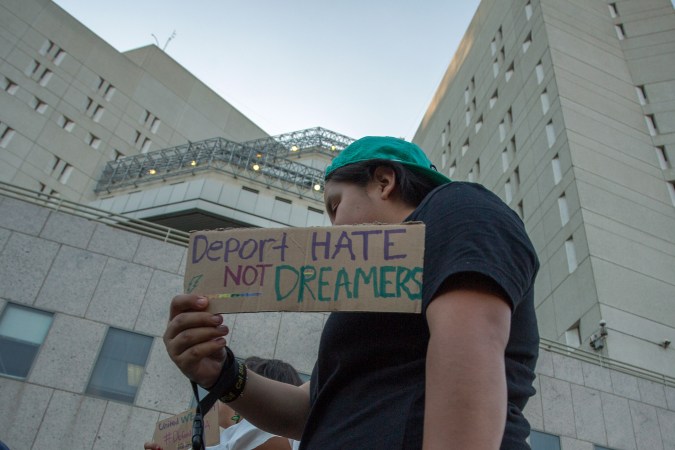
Though views on immigration policy are complicated, with another Pew Research poll showing that more than half of the country wants to increase the number of deportations, there’s overwhelming support for young undocumented immigrants who arrived to the US as children. 72 percent support protecting and providing a path to citizenship to this demographic. A Fox News poll places this number at a higher 83 percent.
In this polarized environment, immigration activists are asking themselves what this means for the movement. DACA passed in 2012 due to their herculean efforts, though they readily acknowledge that the executive order has never been a perfect solution. It didn’t offer a path to citizenship, it was only temporary, and it indirectly demonized the parents who brought their children to the United States. Today, despite a slew of legal challenges to Trump’s end to DACA, Praeli and others say reinstating it is no longer the movement’s focus. “Nothing is as important as securing a legislative fix for permanent status for DREAMers,” Praeli explains. “The administration has shown us that it can’t be trusted. Trump ran on a mass deportation agenda and that’s what he’s doing.”
Beyond pushing for the DREAM Act, activists believe changes in the nation’s public discourse present an opportunity to expand the conversation. The face of DACA – and the immigration movement overall – has been high-achieving young immigrants whose accomplishments made them sympathetic to the general public. Meanwhile, their parents have been painted as criminals for overstaying their visas or entering the country without documentation.
“We are in a very different position right now [than when the DREAM act was introduced].”
In 2014, young activists attempted to remedy this, pressuring Obama to follow DACA with Deferred Action for Parents of Americans and Lawful Permanent Residents (DAPA). The executive order would have granted deferred action status – enabling them to live without the fear of deportation – to undocumented parents who resided in the US since 2010 and whose children were US citizens or permanent residents. But it was soon after challenged, with a federal court blocking it in 2015. Then, on June 2017, John Kelly, then-Secretary of the Department of Homeland Security, canceled out Obama’s executive order with a memorandum. With a stroke of a pen, he delivered the final death knell for DAPA, a program that never offered any peace of mind to the parents who chose to immigrate to the United States.
Today, the DREAMer movement is placing families at the center of the immigration fight. Online, they’ve used the #OriginalDreamers hashtag to honor the sacrifice of parents who risked their lives to start over in the United States. And in meetings with legislators, they push for a clean DREAM Act – that is, a piece of legislation that doesn’t fund the border wall or enact other policies that might harm other undocumented immigrants.
“We are in a very different position right now [than when the DREAM act was introduced],” says Juan Manuel Guzman, an organizer with United We Dream, the largest immigrant youth-led organization. “Legislators now, more than ever, have learned about the movement. There’s a lot of support. We believe we have the energy and the capacity to make it happen.”
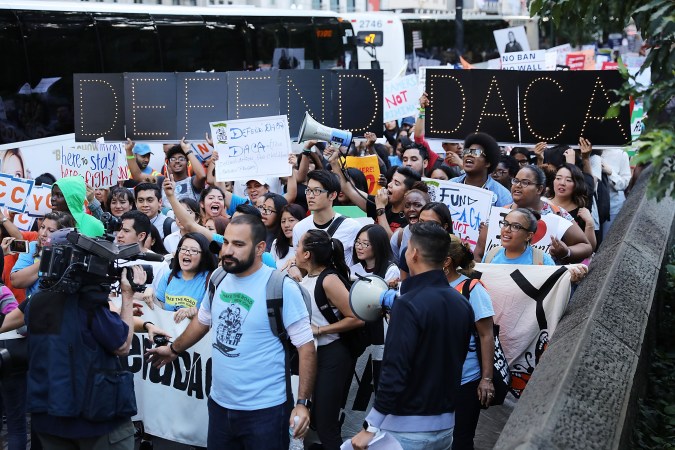
As public perception has changed, so has media coverage. For one, it’s ubiquitous now. The topic DACA appeared on major newspapers’ website, including The New York Times and The Washington Post, considerably more in 2017 than in past years. Outlets are also giving DACA recipients the platform they need. In July, for example, The New York Times published the stories of 126 DREAMers to call for the protection of the program. The interactive feature went viral on Twitter – a tool activists have used to great effect to quickly spread news or to assemble allies in dire situations.
And with corporations like Amazon, Facebook, Apple, General Mills, and many others signing a letter in September urging Trump to save DACA, DREAMers have the backing of powerful entities. Young immigrants are currently in a position where they can leverage all of this support – which has strengthened since DACA became a reality in 2012 – as they continue to push back.
Congress is overwhelmingly for DACA as well. Many conservative Republicans have publicly thrown their support behind DACA recipients, according to Vox. Just like a majority of the country, Congress also wants to provide a path to citizenship for this group. Two of the three DREAMer bills would allow these young immigrants to become naturalized. But what it comes down to is that Congress wants to use DACA recipients to further Trump’s anti-immigrant agenda, something activists and progressive officials refuse to cede way to. On January 6, Trump once again reiterated that he has no issue saving one immigrant group at the expense of another. “We want the wall,” he said at a press conference, according to Time. “The wall is going to happen, or we’re not going to have DACA.”
With a Republican Congress and administration at the helm, activists know the DREAM Act needs to come attached to another piece of legislation. That’s why the upcoming January 19 spending bill deadline is so important. The DACAmented community will continue to pressure Congress to refuse to vote on the bill – risking a government shutdown – unless it’s attached to one of the versions of the DREAM Act. The legislative body failed to deliver this protection to DACA recipients in December.
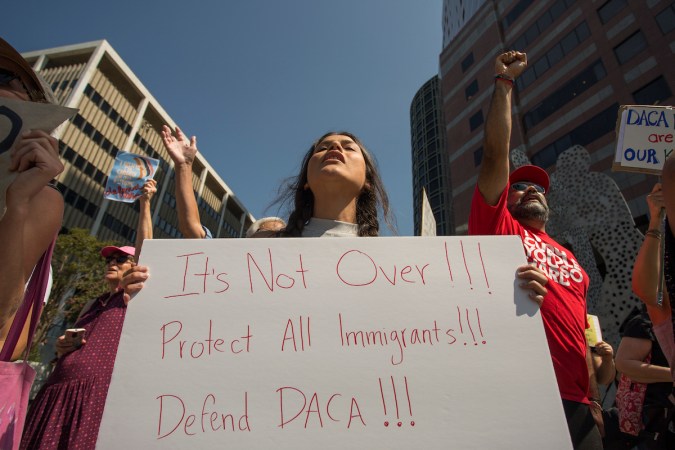
There are less than two months until March 5, and there’s no indication that the Trump Administration has any plans for DACA recipients should Congress not reach a deal in time. As a matter of fact, videos of a January 9 bipartisan meeting with Trump showed how little guidance the White House is providing. In the almost hour-long conversation, Trump contradicted himself by saying he’d sign comprehensive immigration reform as well as a stand-alone DACA bill.
Later that day, a federal judge in California issued a nationwide injunction, essentially restarting the program again. Judge Williams Alsup wrote that DACA cannot end when Trump’s decision still faces legal challenge. The administration could challenge the ruling, which could make the injunction null. But regardless of how this plays out, it doesn’t change the plans of activists who know DACA is no longer the goal.
The movement lost some momentum after DACA passed. “Folks got DACA and went on with their lives,” Roberto Gonzales, a Harvard University professor who studies undocumented youth, tells the Los Angeles Times. But Trump’s election and his decision to end the program forced some DACA recipients to take up the fight again, to refuse to retreat, and it encouraged others to join for the first time.
Activists are taking the same approach as in December, it’s just the deadline that has changed. Immigration groups hope to pressure Democrats – especially those who supported the last spending bill – to force a government shutdown on January 19 if their demands aren’t met. There are already protests and actions planned across the country this year, and surely there will be more to come. Because if we’ve learned anything from looking at the work immigrants have put in over the last decades it’s that as long as we have a broken immigration system, the struggle will continue. As we ponder what happens if no fix comes in March, we have to remember that DACA’s protection from deportation didn’t create fearless activists. All we have to do is look at life pre-DACA to see proof of that.




